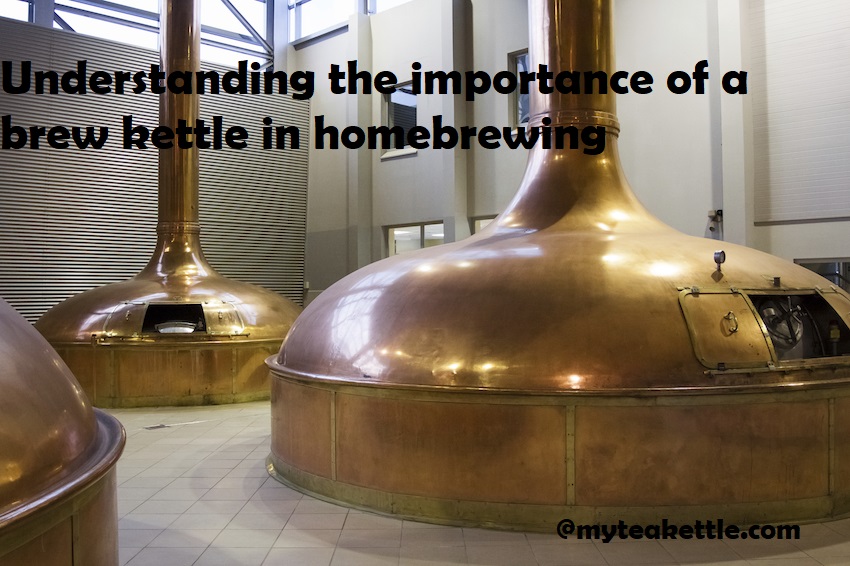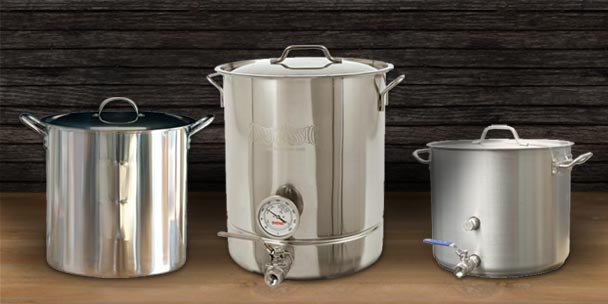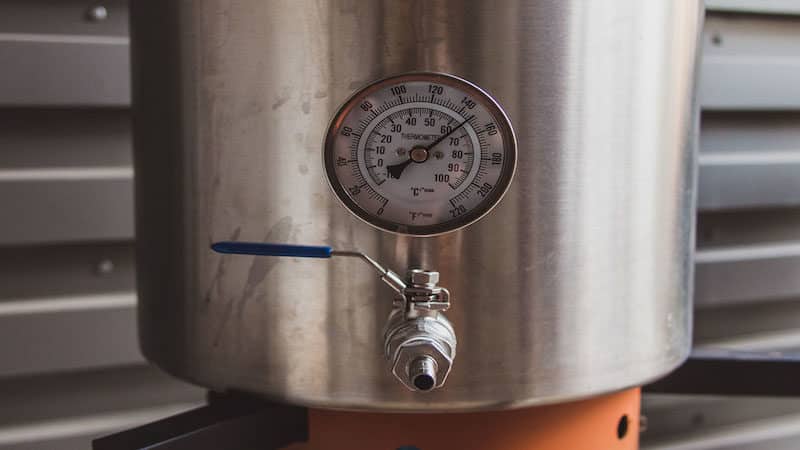Are you a homebrewer looking to unlock the secrets of the perfect beer? Brew kettles are essential equipment for creating delicious craft beers. You need to know how to use them to get the best results.
This guide will provide all the information you need about brew kettles for homebrewing.
Having the right gear can make a major difference when it comes to home brewing. The brew kettle serves as a fundamental component of the brewing process, so it’s important to understand how it works and how to use it properly. This guide will provide an introduction to working with brew kettles and some tips for getting the most out of them.
The brew kettle is used for boiling wort, or the malt-sugar solution that will later become beer after fermentation. The boiling process helps develop flavor and hop bitterness in beer, as well as sterilize it for further fermentation processes. When selecting a brew kettle, there are several important factors to consider such as size, material and features.
When looking at size, be sure to get one that is large enough to accommodate your recipe’s volume requirements while leaving room at the surface of the liquid for foam and heat losses during boiling. As far as material is concerned, stainless steel is by far the most popular option but other materials like aluminum can be attractive due to lower cost and lighter weight but they may require more frequent replacement due to corrosion issues. In addition, check out any bells or whistles that may come with your brew pot such as thermometers on lids or specialty valves; these can be useful depending on your desired applications. After you’ve chosen a good quality pot that meets your specific needs its time get brewing!

Explanation of homebrewing
Homebrewing is the process of using equipment and ingredients to produce beer, mead and cider on a small or hobbyist scale. It is typically done in a home kitchen, garage or backyard. There are two main steps involved in homebrewing: the first being preparation of the ingredients, followed by fermentation.
The process of homebrewing requires certain pieces of equipment such as fermenters and bottles for storing your open batches. One important piece of equipment that many home-based brewers overlook is the brew kettle, which plays an essential role in any successful brew day.
The brew kettle is used to steep grains and dissolve specialty sugars, as well as for boiling beer wort to obtain bittering compounds and desirable hop profile flavors. The most common type of brew kettles are constructed out of stainless steel with a lid for easy access. A good-quality kettle should also have thick walls, stay relatively cool on the outside during use, be easy to clean and maintain its shape over years of wear and tear.
Homebrewers typically choose either an electric or gas heated version depending upon their desired style of brewing – electric being suited better for all-grain brewing whereas gas works best for extract based batches. It’s also important to pay attention to size when selecting a kettle – larger sizes will require more effort while smaller ones may be restrictive when creating bigger batches of beer or other beverages.
Importance of a brew kettle in homebrewing
The brew kettle is a critical component of homebrewing and plays an important role in producing quality beer. A brew kettle gives the brewer control over their wort and enables them to produce beer that meets their desired flavor profile. It also serves as a heated vessel for boiling water or other liquids, which helps break down starches into sugars that can be used in the fermentation process.
A brew kettle is usually constructed of stainless steel or aluminum, allowing for maximum heat transfer efficiency, as well as resistance to corrosion and staining. The size of the brew kettle you choose will depend on your brewing capacity, and when selecting a kettle it’s important to consider both maximum batch size and typical batch sizes you plan on brewing. Additionally, adding additional accessories such as a whirlpool arm or false bottom can further enhance the performance of your kettle.
The brew kettle allows you to extract essential oils from hops during hop utilization stages or add additional flavors during other stages such as late boil additions or flameout additions. Adding these components at certain intervals will enable increased efficiency by keeping all flavors evenly distributed throughout your beer instead of concentrated only toward the bottom. The boil also makes it easier for proteins, dextrins, and carbohydrates to reach concentrations that are ideal for conversion into sugars used in fermentation. The amount of time spent boiling ultimately depends on the recipe but successful home brewers understand that boiling times need to be adjusted based on brewery set up and desired flavor outcomes from ingredients added at specific intervals during a boil stage.
Features to Look for in a Brew Kettle
When it comes to homebrewing, investing in a good quality brew kettle is critical. The right brew kettle can make or break a beer recipe, so it is important to have one that meets your specific needs and has the features necessary to produce a great beer. This guide outlines some key features of a brew kettle that are important to consider when selecting one for your homebrewing setup.
- Capacity: The capacity of your brew kettle should be sufficient for the batch size you typically make, as it will limit the amount of wort/beer you can make in one session. Smaller pots may only accommodate 2-4 gallons (7-15 liters) of wort at a time, while large pots can hold up to 20 gallons (76 liters) or more at once. Make sure to consider how much beer you plan on making and get an appropriately sized vessel!
- Material: Most kettles are made from either stainless steel or aluminum. Aluminum is generally less expensive but can cause soft water beers or beers with high oxidation potentials (sourness levels ) like IPAs to taste off due to oxidation occurring in the material when exposed to air and light while boiling. Stainless steel is more expensive but provides better protection against oxidation than aluminum kettles do – this could mean better tasting beer if you’re making IPA-style ales!
- Wall Thickness: When selecting an appropriate brew kettle, wall thickness should also be taken into account as thicker walls will maintain heat over longer periods of time and potentially reduce boil times during extract brewing processes where higher temperatures must be maintained for longer periods of time during extract processes involving boiling larger amounts of water with extracts and hops added at different stages throughout the boil process. Additionally, thicker walls allow there to be more heat insulation between your fire source and the pot which prevents overheating or burning out your pot from extreme temperatures which could lead to off-flavors in finished beers made with such equipment!
- Included Accessories: Some brew kettles come with extras like thermometers, bottle openers, spigots, grates or strainers which could increase contact between hot liquid and air – thus increasing oxidation potential levels – so these items might need extra care if included on a vessel for long term storage when using grains like pale malts which are known for their vulnerability against oxygen exposure! Additionally having these accessories included in your kit may also reduce cost by eliminating areas where separate purchases would otherwise need to occur in order ‘assemble’ all components necessary for successful home brewing!
Heat distribution
When it comes to brewing beer at home, one of the most important pieces of equipment to have is a brew kettle. It is an essential part of the entire process that allows for effective heat distribution when boiling all of your ingredients.
The brew kettle is typically made from thick stainless steel, which helps to ensure even temperatures throughout the brewing process. This makes it easier to reach higher temperatures and it also helps ensure that no corners are cut when it comes to sanitation. Additionally, many models come with thermometers built in, which can help brewers monitor temperature during the boil.
The shape and size of the brew kettle will depend on the size and type of beer being brewed, but generally speaking they should be at least three gallons in size in order to accommodate enough volume for a five-gallon batch of beer. The ideal ratio between volume and surface area should be two quarts per square foot as too much or too little surface area can cause your wort (or unfermented beer) to evaporate quickly, scorch or stick to the bottom during boiling.
Handles
The handles of a brew kettle are important for safety and convenience. The handle should be positioned far enough away from the heat source to ensure the brewer can lift the brew kettle with ease and without being burned.
Some kettles may come with an attached handle, but this may be too hot to touch causing discomfort when handling and moving the brew kettle. In these cases, it is advisable to invest in a secondary handle covered with heat-resistant material that will never be exposed to direct heat. This will offer more comfort and make transferring full or heavy kettles easier.
III. Benefits of Using a Brew Kettle
Brew kettles are the most essential items when it comes to homebrewing a high-quality beer. Brew kettles are stainless steel vessels used to boil wort and remove trub from liquid. The boiling process not only serves to sanitize the liquid, but also encourages the Maillard reactions that give beer its unique flavor profiles.
Aside from boiling, brew kettles also offer several benefits during the brewing process. When using a kettle, you can easily scoop out impurities and particles that would otherwise be too small for other methods of filtration. Additionally, the use of a brew kettle helps create an ideal environment for hops additions by preventing splashing and making it easier to precisely control hop usage levels.
Finally, another great benefit of brew kettles is they are fairly inexpensive compared to other brewing equipment. With proper maintenance, a well-made stainless steel boiler should last you many years with no problems and minimal care—making it one of the most economical pieces of brewing equipment available on the market today!
Improved brewing process
A brew kettle is a fundamental component of any home brewing system since it provides a container for boiling wort and thus initiating the chemical changes necessary for mashing and lautering. In addition to this, a brew kettle also serves as a convenient tool to perform hot side aeration as well as providing an opportunity to hop addition at different stages of the boil. Depending on the type of beer being brewed, small or large quantities of hops can be introduced during hop stand periods or added gradually prior to boiling.
There are several types of brew kettles available in the market, such as stainless steel kettles, plastic ones and aluminized kettles that come in different sizes and capacities suitable for home brewers depending on their brewing needs.
Although the use of brew kettles is flexible enough so that brewers are able to experiment with different recipes and methods, there are some rules that should be followed when selecting and using them. Firstly, when selecting a type of brew kettle for your homebrewing setup, make sure you choose an appropriate size given your particular batch size in order to avoid excessively long boiling times due to overfilled wort volumes. Secondly, if possible stick with stainless steel kettles since they can withstand temperature variations better than plastic ones. Finally, check regularly if there are any standing orders from brewing authorities regarding local health regulations regarding materials that enter food contact during preparation processes such as brewery equipment including the quality of metal used in producing each item, it’s important to keep up with local health regulations so your product remains safe for human consumption while still being efficient enough not to require too many steps when producing each beer variety you are making.
Better control over brewing
One of the biggest advantages of using a brew kettle in homebrewing is that it gives you better control over your brewing process. Because you can use temperature-controlled heating elements, you can easily adjust the temperature for a precise final product. Additionally, if your setup includes a built-in thermometer, you can monitor and record the temperatures throughout all stages of the brewing process – from mashing to fermentation and beyond. This helps ensure that each batch turns out exactly as expected every time.
Furthermore, by using precise measurements, it’s easier to replicate recipes or make small modifications based on your particular needs or flavor preferences.
Enhanced flavors and aromas
Coffee kettles, also referred to as brew kettles are essential components of any homebrewing setup. Not only do they provide a convenient way to dispense the liquid from the wort chiller into your fermenter, but they can also enhance the flavors and aromas of any beer or cider you make.
By adding airstones or diffusers to your kettle, you can create a whirlpool creating a gentle and even agitation of the wort. This can help extract more flavor solids from grains, hops and other ingredients as possible, allowing you to achieve fuller and more complex flavors for your brewing recipes.
In addition, coffee kettles are great for boiling greater amounts of water with less energy required due to their large capacity. Coffee kettles come in a variety of capacities ranging from 7 gallons all the way up to 23 gallons making them perfect for larger brewing volumes if needed. They also come in both aluminum and stainless steel designs So no matter what type of homebrewer you are there’s likely a perfect model out there for you!
Conclusion
In conclusion, it is evident that possessing a quality brew kettle is paramount when it comes to homebrewing success. Brewing kettles come in various sizes, shapes and made of different materials. Knowing the purpose and qualities of the different types of brew kettles will help you determine which kettle is best for your brewing needs.
Taking safety precautions when using brew kettles such as properly affixing your lid, working in a well ventilated area, and moving your brew kettle with caution are essential for harm-free brewing experience.
Understanding effective techniques such as sparging and reading thermometers will also help ensure that you create a quality batch of delicious homebrew every time.
FAQ’s
Do I need a brew kettle?
Yes, a brew kettle is an essential piece of equipment for homebrewing.
What should I look for in a brew kettle?
You should look for a kettle that is large enough to accommodate your batch size, made of durable materials, has good heat distribution, and includes a lid and thermometer.
What is the importance of wort boiling in brewing?
Wort boiling is important because it sterilizes the wort, extracts bitterness from hops, and evaporates off unwanted volatiles.
What are the benefits of capturing steam from brew kettle?
Capturing steam from the brew kettle can help reduce humidity in your brewing area, prevent moisture-related damage, and potentially even save energy.
How important is it to use a kettle?
Using a kettle is very important in the brewing process, as it is where you heat and boil the wort, and add hops and other ingredients.
What is the point of a kettle?
The point of a kettle in brewing is to heat and boil the wort, extract bitterness from hops, and evaporate off unwanted volatiles.
Can you ferment in brew kettle?
No, you cannot ferment in a brew kettle. Fermentation requires a separate vessel, such as a carboy or fermenting bucket.
Should you empty kettle after every use?
Yes, it is a good idea to empty and clean your brew kettle after every use to prevent any buildup of sediment or bacteria.
What size brew kettle is best?
The best size brew kettle depends on your batch size, but generally, a 5-gallon kettle is suitable for 5-gallon batches, while a 10-gallon kettle is suitable for 10-gallon batches.
Is brew kettle good?
Yes, a good brew kettle is an important investment for any homebrewer, as it can affect the quality and consistency of your beer.
See Also-
- Best gooseneck kettle
- Best tea kettle for glass cooktop
- Best tea kettle for gas stove
- Best solar kettle
- Best stainless steel tea kettle

